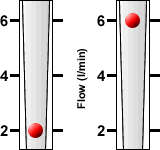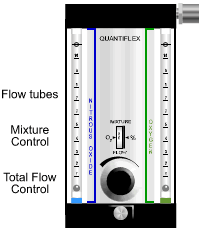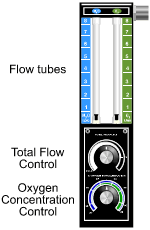|
Flowmeters
and gas flow regulation
Valves
The needle valve is the most common means of regulating gas flow
rate. As the valve is opened, the orifice around the needle becomes
larger and flow increases. The valve cartridge itself is usually
removable so it can be replaced if it is damaged.
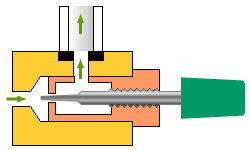
The valve must
not be over-tightened--this will drill out the orifice and cause
it to become incompetent. Some valves, such as are found on most
medical anesthetic machines, incorporate a stop to prevent the valve
being over-tightened. The
valve control knob is usually color-coded. In addition, oxygen flowmeter
knobs frequently have fluted edges to distinguish them from those
of other gases.

Flowmeters
Flowmeters on modern anesthetic machines consist of a tapered glass
tube containing a bobbin or ball which floats on the stream of moving
gas.
As the gas flow
rate increases, the float is carried further up the tube, so indicating
the flow rate.
-
Flowmeters
are specifically constructed for each gas, since the flow
rate depends on both the viscosity and density of the gas.
-
Only
the correct tube and bobbin or ball can be used to repair
broken flowmeters.
-
Since
the bobbin floats in the gas stream, flowmeters will only
function correctly if the tube is vertical.
-
Flowmeters will not function correctly if the tube is cracked.
Bobbins
and balls
Bobbin
flowmeters are more accurate, but more expensive, and should
be read from the top of the bobbin (the shape of the bobbin
is designed to optimize gas flow, and has nothing to do with
being a 'pointer'). Ball float types should be read from the
middle of the ball.
 |
 |
Bobbin
flowmeter,
reading 2 l/min |
Ball-float
flowmeter,
reading 2 l/min |
Inaccuracy
in flowmeters
May be due to:
-
The
tube not being vertical.
- Back-pressure
from, for example, a ventilator.
- Static electricity
causing the float to stick to the tube.
- Dirt causing
the float to stick to the tube.
Sequence
of flowmeters
If several flowmeters are mounted together and a leak develops
in one flow tube, a higher proportion of the gas coming from
the upstream flowmeter will tend to be lost through the leak.
If the oxygen flowmeter is upstream, this will tend to deliver
a hypoxic misture to the patient.

Oxygen flowmeters
should, therefore, always be mounted downstream of any other flowmeters,
although there is no international agreement on this position.
Nitrous oxide/oxygen
proportioning flowmeters
Owing to the
potential hazards of delivering hypoxic gas mixtures to patients,
a number of manufacturers developed nitrous oxide/oxygen proportioning
flowmeters. In these, the separate oxygen and nitrous oxide control
knobs are replaced with a single flow control and a proportioning
valve that allows adjustment of the output oxygen concentration
from 30% to 100%.
Other machines have retained the separate
oxygen and nitrous oxide flow control knobs, but these are linked
mechanically or pneumatically so that it is impossible to deliver
less than a specified oxygen concentration (typically 25% to 30%
oxygen).
Other
flowmeters
| Turret-type
flowmeters, in which the gas leaves the flowmeter from the bottom
of the unit, are usually used to deliver oxygen in intensive-care
situations, but may be found on some anesthesia machines (e.g.
older Dräger models). |
 |
| Acrylic-bodied
flowmeters are fitted on some less expensive machines. These
have a tendency to crack unless they are used with care. |
 |
| The
Heidbrink flowmeter is found on some older Ohio anesthesia
machines, as well as Pitman-Moore 960 and 970 machines. The
gas flow is read from the top of the vertical bar. |
 |
Bourdon
flowmeters
are found on flow-limited regulators (for delivery of oxygen
directly to patients) but are not usually used on anesthetic
machines. They consist of an adjustable pressure supply, a pressure
gauge (calibrated in units of flow) and a special orifice. As
the pressure is increased, flow through the orifice increases,
which is reflected by the gauge.
One problem with this type of flowmeter
is that if the orifice becomes partially blocked, the flowmeter
will over-read (since, for any given pressure, the flow will
be less because of the increased resistance of the orifice),
and vice versa.
|
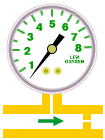 |
Vaporizers 
|



